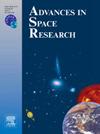A wave scattering approach to modelling surface roughness in orbital aerodynamics
IF 2.8
3区 地球科学
Q2 ASTRONOMY & ASTROPHYSICS
引用次数: 0
Abstract
The growing number of space objects in low-Earth orbit necessitates accurate orbit predictions to decrease the likelihood of operational disruptions. The challenges in accurately capturing how gas particles interact with the objects’ surfaces result in uncertainties in their aerodynamic coefficients, directly affecting the accuracy of orbital perturbation models. Currently, gas–solid boundary interactions are accounted for by empirical models like those proposed by Sentman and Cercignani-Lampis-Lord. These models have one or two adjustable parameters, typically tuned based on orbital tracking and acceleration data. However, these models are inadequate in accurately representing crucial processes at the gas–solid interface such as multiple reflections, shadowing, and backscattering resulting from the roughness of real surfaces. We propose a new, physics-based gas-surface interaction model that leverages electromagnetic wave theory to incorporate macroscopic effects on the gas particle scattering distribution resulting from surface roughness. Besides better describing the physics of gas-surface interaction, this model’s parameters can be determined by combining ground measurements to characterise the surface roughness and molecular dynamics simulations to specify the atomic-scale interaction. The model is verified for the entire parameter range using a test-particle Monte Carlo approach on a simulated rough surface. In addition, we successfully replicate several experimental results available in literature on the scattering of Argon and Helium on smooth and rough Kapton and Aluminium surfaces. We conclude by demonstrating the model’s effect on the aerodynamic coefficients for simple shapes and comparing these results with those produced with the Sentman and Cercignani-Lampis-Lord models, thereby demonstrating that previously observed inconsistencies between these models and tracking data of spherical satellites can be explained by surface roughness.
轨道空气动力学中表面粗糙度建模的波散射方法
近地轨道上空间物体的数量不断增加,需要精确的轨道预测,以减少业务中断的可能性。准确捕捉气体粒子如何与物体表面相互作用的挑战导致其空气动力学系数的不确定性,直接影响轨道摄动模型的准确性。目前,气固边界相互作用是由Sentman和Cercignani-Lampis-Lord提出的经验模型来解释的。这些模型有一个或两个可调参数,通常根据轨道跟踪和加速度数据进行调整。然而,这些模型不足以准确地表示气固界面上的关键过程,例如由真实表面粗糙度引起的多次反射、阴影和后向散射。我们提出了一个新的,基于物理的气体表面相互作用模型,该模型利用电磁波理论来考虑由表面粗糙度引起的气体颗粒散射分布的宏观影响。除了更好地描述气体表面相互作用的物理特性外,该模型的参数还可以通过结合地面测量来表征表面粗糙度和分子动力学模拟来确定原子尺度的相互作用。在模拟粗糙表面上,采用测试粒子蒙特卡罗方法验证了该模型在整个参数范围内的正确性。此外,我们成功地复制了一些文献中关于氩和氦在光滑和粗糙的卡普顿和铝表面上散射的实验结果。最后,我们展示了模型对简单形状的空气动力学系数的影响,并将这些结果与Sentman和Cercignani-Lampis-Lord模型产生的结果进行了比较,从而证明了先前观察到的这些模型与球形卫星跟踪数据之间的不一致可以用表面粗糙度来解释。
本文章由计算机程序翻译,如有差异,请以英文原文为准。
求助全文
约1分钟内获得全文
求助全文
来源期刊

Advances in Space Research
地学天文-地球科学综合
CiteScore
5.20
自引率
11.50%
发文量
800
审稿时长
5.8 months
期刊介绍:
The COSPAR publication Advances in Space Research (ASR) is an open journal covering all areas of space research including: space studies of the Earth''s surface, meteorology, climate, the Earth-Moon system, planets and small bodies of the solar system, upper atmospheres, ionospheres and magnetospheres of the Earth and planets including reference atmospheres, space plasmas in the solar system, astrophysics from space, materials sciences in space, fundamental physics in space, space debris, space weather, Earth observations of space phenomena, etc.
NB: Please note that manuscripts related to life sciences as related to space are no more accepted for submission to Advances in Space Research. Such manuscripts should now be submitted to the new COSPAR Journal Life Sciences in Space Research (LSSR).
All submissions are reviewed by two scientists in the field. COSPAR is an interdisciplinary scientific organization concerned with the progress of space research on an international scale. Operating under the rules of ICSU, COSPAR ignores political considerations and considers all questions solely from the scientific viewpoint.
 求助内容:
求助内容: 应助结果提醒方式:
应助结果提醒方式:


